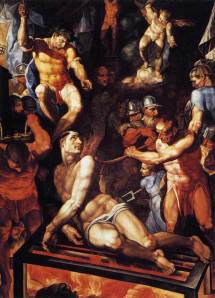 |
| Canaanite woman and Jesus, Duc de Berry (circa 1410) |
Twentieth Sunday in Ordinary Time (Year "A") - August 14, 2011 - JESUS DIALOGUES WITH A FEISTY MOTHER
[Texts: Isaiah 56:1, 6-7 [Psalm 67]; Romans 11:13-15, 29-32; Matthew 15:21-28]
In last Sunday's gospel, Jesus chided Simon Peter for being a man of "little faith". Such "little faith", mixed with doubt and hesitation, characterizes members of the church even after Easter (Matthew 28.17).
This Sunday, we encounter a pagan woman, a Canaanite who, contrary to all expectations, manifested “great faith”. She serves as a model for believing disciples.
Matthew tells the story of her encounter with Jesus through a carefully crafted set of exchanges. It begins with the appeal of the woman herself for the cure of her daughter (verses 22-23); followed by the disciples' discussion with Jesus (vv. 23-24) and closing, finally, with Jesus' direct contact with the woman and the granting of her petition (vv. 25-28).
After a testy exchange with the Pharisees (Matthew 15.1-20), Jesus “withdrew”—a typical action of his in this gospel—and headed for the pagan region of Tyre and Sidon
Instead of simply designating her as a foreigner, Matthew specified that she was a Canaanite, a pagan member of one of the peoples said to have been forever excluded from membership in the people of God on account of ancient hostilities (cf. Deuteronomy 7.1-6; 20.16-18).
Now, becoming a convert to Judaism meant more than simply believing in God; it implied, as well, becoming submissive to the faith community and adopting its rituals and customs. This would have been very hard for Canaanites to do.
Some Jewish rabbis in the time of Jesus allowed Canaanites to become members of the community of believers, citing Rahab's integration into the Israelite faith as precedent (Joshua 2. 6-25); interestingly, Matthew mentions Rahab in the geneaology of David and Jesus (1.5).
Scholars have speculated that at the time Matthew's gospel was composed, members of the Christian community with Jewish roots were wondering whether such people could be admitted to the church.
The disciples are pragmatic, regularly seeking to resolve difficulties with despatch. Earlier they had suggested to Jesus that he send the crowds home at the time he decided to work the miracle of the loaves (Matthew 14.15). Now they ask Jesus to send her away—with her petition heard or unheard we are not told, only the reason the disciples give for her dismissal—“for she keeps shouting after us”.
But sending her away would mean addressing a word to her and, through her, speaking to the Gentiles, whereas, Jesus had said that his mission was only to the “lost sheep of the house of Israel
After the disciples disappear from the scene, the woman and Jesus enter into a dialogue. Kneeling in petition, she immediately speaks a prayer of the liturgy, “Lord, help me”. In explaining his refusal Jesus explained his mission as one of giving bread to the children (Israel) and not feeding the house dogs (the Gentiles), the mission that would fall to his disciples, the church.
Though slighted by this slur, the woman was not taken aback but went forward in faith, noting that house dogs eat scraps that fall from the table. She explained why this circumstance was unfair and asked whether his mission might not allow others to share in the blessings he brings—even if as a secondary effect (“yet even the dogs eat the crumbs that fall from their masters' table”). Desperately her faith sought her daughter's cure.
Amazed by her faith, Jesus granted her petition; no one else received the kind of accolade she did (“Woman, great is your faith! Let it be done for you as you wish”). Her faith anticipated the time of the Church when a “new Israel Israel
* * * * * *
ST. LAWRENCE, DEACON & MARTYR
Today's liturgy observes the feast of St. Lawrence Martyr, a Roman who lived in the third century, one of seven deacons in charge of giving help to the poor and the needy.
When a persecution broke out, Sixtus, bishop of Rome, was condemned to death. As he went to execution, Lawrence followed him weeping. “Father, where are you going without your deacon?” “I am not leaving you, my son,” Sixtus answered. “In three days you will follow me.” Full of joy, Lawrence gave to the poor the rest of the money he had on hand. He even sold expensive church vessels to have more to give away.
The prefect of Rome, a greedy man, thought the Church had a great fortune hidden away. He ordered Lawrence to bring the Church’s treasure to him. The saint said he would, in three days. Then he went through the city and gathered together all the poor and sick people whom the Church supported. He showed them to the prefect and said: “This is the Church’s treasure.”
The prefect was furious. In his anger, he condemned Lawrence to a slow, cruel death. The saint was tied on top of an iron grill over a slow fire that roasted him. Lawrence joked to the judge, “Turn me over; I'm done on this side.”
Before he died, he prayed that the city of Rome might be converted to Jesus. He prayed that the holy faith would spread all over the world. Lawrence died on August 10, 158; his feast spread throughout Italy and to northern Africa.
* * * * * *
 |
| Fra Angelico, Pope St. Sixtus II ordains St. Lawrence, the deacon (1447-1449) |

No comments:
Post a Comment